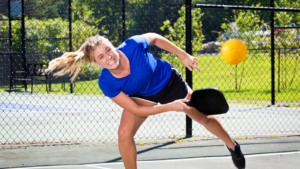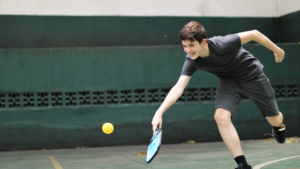The gentle tap of the paddle, the inflatable pop as the ball makes contact, and the opponents left in awe as they watch it gracefully land just over the net. Ah, the art of the dink shot in pickleball, a stroke of finesse that can elevate your soft game to new heights. Whether you’re a beginner seeking to master this delicate technique or an experienced player looking to refine your touch, our ultimate pickleball dink shot guide is here to equip you with the skills needed to dominate the court. Get ready to transform your game and leave your competitors scrambling with a stroke that’s as smooth as silk.
Table of Contents
- Mastering the Fundamentals of the Dink Shot
- Unleashing Precision and Control: Perfecting Your Placement and Angle
- Crucial Techniques for Optimal Soft Game Performance
- Choosing the Ideal Paddle and Gripping Technique for Dink Shots
- Strategic Approaches to Disrupt Your Opponent’s Game
- Q&A
- Closing Remarks

Mastering the Fundamentals of the Dink Shot
When it comes to the game of pickleball, the dink shot is an essential skill that every player should master. This delicate shot involves softly dropping the ball over the net, just barely clearing it and putting your opponents in a tough spot. To become a proficient dink shot player, it is crucial to understand and practice the fundamentals that make this shot effective.
1. Proper Grip: One of the first things to focus on when mastering the dink shot is the grip. Ensure that you have a loose and relaxed grip on your paddle, allowing for better control and maneuverability. Avoid excessive tension in your hand, as it can hinder your ability to execute the shot with finesse.
2. Soft Touch: The key to a successful dink shot lies in its softness. Aim to make contact with the ball using a gentle touch, almost like you’re caressing it. Keep your wrist relaxed and the paddle face open, allowing for a smooth and controlled movement. By maintaining a soft touch, you’ll be able to place the ball accurately and keep it low, making it challenging for your opponents to return.
3. Maintain a Low Stance: To have better control over the dink shot, it is crucial to maintain a low and balanced stance. Bend your knees slightly and keep your weight centered for improved stability. This position will allow you to react quickly and position yourself accurately to better execute the shot.
By focusing on these fundamentals and practicing regularly, you’ll be well on your way to mastering the dink shot. Remember, patience and consistency are key, so don’t be discouraged if it takes time to perfect this important skill. With dedication and practice, you’ll be able to incorporate the dink shot seamlessly into your pickleball strategy, giving you a significant advantage on the court.

Unleashing Precision and Control: Perfecting Your Placement and Angle
When it comes to achieving flawless results, precision and control are paramount. Whether you’re a seasoned professional or just starting out, mastering your placement and angle can elevate your skills to new heights.
Placement: This crucial aspect determines where your focus lies and can greatly impact the outcome of your task. Consider these tips to enhance your placement:
- Take your time to assess the situation and plan your placement strategically.
- Ensure a firm and stable base to work from, providing a solid foundation for your actions.
- Study the environment or canvas, understanding its unique characteristics before executing your placement.
Angle: The angle at which you approach a task can make a world of difference in its execution. Pay attention to these factors to perfect your angle:
- Experiment with various angles to find the optimal one for your specific task.
- Consider the lighting and its effect on the angle you choose, as it can alter shadows and highlights.
- Maintain a steady hand and a focused mindset to ensure consistency in your angle throughout your task.
By harnessing precision and control, and becoming a master of placement and angle, you’ll unlock a world of potential in your endeavors. Practice diligently and embrace the artistry of your craft, as the journey towards perfection begins with honing these fundamental skills.
Crucial Techniques for Optimal Soft Game Performance
In every soft game player’s journey, there are key techniques that can significantly enhance their performance on and off the virtual field. Mastering these skills can often be the difference between victory and defeat. To help you level up your soft game expertise, we’ve compiled a list of essential techniques:
- Fluid Communication: Communication is the backbone of any successful team. Soft game players must be able to effectively convey their strategy, provide updates, and coordinate movements with their teammates. Strong and clear communication can help establish trust and ensure the team acts as a cohesive unit.
- Mindful Awareness: To excel in soft games, it’s crucial to have a heightened sense of awareness. Pay attention to the details, constantly surveying the field and adapting to the ever-changing dynamics. By being mindful and staying alert to both opportunities and potential threats, you can make faster and more informed decisions when it matters most.
- Strategic Positioning: Positioning is a fundamental aspect of soft games. Knowing where to position yourself on the field can give you a significant advantage. Study the game’s mechanics, map layouts, and popular strategies to make more effective moves. Adapting your position in real-time based on your team’s needs can often lead to game-changing plays.
Incorporating these techniques into your soft game arsenal can help you skyrocket your performance to new heights. Remember, practice makes perfect, so don’t be afraid to immerse yourself in the game, experiment with different strategies, and refine your skills. Enjoy the journey of becoming a soft game master!
Choosing the Ideal Paddle and Gripping Technique for Dink Shots
When it comes to mastering dink shots, choosing the right paddle and grip technique can make all the difference in your game. We all know that dinks require finesse, precision, and accuracy, and having the ideal equipment is essential to achieve this.
First and foremost, let’s dive into selecting the perfect paddle. It’s crucial to find a paddle that offers excellent control and feel. Look for a paddle with a soft core, as it will absorb the impact of the ball and provide better control in dink shots. Additionally, consider the weight and grip size of the paddle. Opt for a lightweight paddle that allows for quicker wrist movement and better maneuverability. As for grip size, make sure it comfortably fits your hand so that you can maintain control and stability throughout your shots.
Now that you have the right paddle, let’s discuss gripping techniques. For beginners, the continental grip is often recommended. This grip involves holding the paddle handle with your index knuckle resting on the backside. It provides versatility and control, allowing you to easily switch between forehand and backhand shots. Once you feel more comfortable and want to explore advanced techniques, you can experiment with the eastern or western grips to add spin and variety to your dink shots.
- Continental Grip: The index knuckle rests on the backside of the paddle handle, providing versatility and control.
- Eastern Grip: The handle is held with the base knuckle of your index finger on the front side, allowing for more topspin and power.
- Western Grip: The handle is held with the base knuckle of your index finger on the backside, enabling more underspin for defensive shots.
Remember, finding the ideal paddle and gripping technique involves experimentation and practice. Take the time to test different paddles and grips to discover what works best for your playing style. So, get out there, grab your paddle, and nail those dink shots with finesse!
Strategic Approaches to Disrupt Your Opponent’s Game
When it comes to competitive gaming, finding ways to disrupt your opponent’s game can give you a significant advantage. By implementing clever strategies and utilizing unique tactics, you can throw your opponents off balance and secure a favorable outcome for yourself. Here are some tactical approaches to consider:
- Knowledge is Power: One of the most effective ways to disrupt your opponent’s game is to study and understand their playstyle. Take the time to analyze their strengths and weaknesses, spotting any patterns or tendencies. Armed with this information, you can adapt and counter their moves, rendering them less effective.
- Apply Pressure: Applying pressure is an effective way to disrupt your opponent’s rhythm and force them into making mistakes. This can be achieved by constantly staying on the offensive, controlling key points on the battlefield, or setting traps that catch them off guard. By maintaining a relentless presence, you can instill doubt in your opponent’s mind and make them second-guess their decisions.
- Adaptability is Key: Nothing disrupts an opponent’s game plan more than adaptability. By constantly switching tactics, alternating strategies, and employing unexpected maneuvers, you keep your opponent guessing and prevent them from settling into a comfortable rhythm. Always be willing to think outside the box and adjust your game on the fly.
Implementing these strategic approaches will not only disrupt your opponent’s game but also give you an edge over them. Remember, flexibility, knowledge, and constant pressure are the keys to victory. Stay one step ahead and watch as your opponents struggle to keep up with your unpredictable gameplay.
Q&A
What is a dink shot in pickleball?
A dink shot in pickleball is a soft shot that is hit with a low trajectory, landing just over the net and close to the opponent’s baseline. It is a strategic shot used to prevent the opponent from attacking aggressively.
Why is the dink shot important in pickleball?
The dink shot is important because it allows players to control the pace of the game and disrupt the opponent’s rhythm. It can force the opponent into a defensive position, providing opportunities for more aggressive shots.
How can I improve my dink shot?
To improve your dink shot, focus on your grip and paddle angle. Use a loose grip and a slight upward angle on the paddle face to generate backspin. Practice with a partner to develop consistency and accuracy.
When should I use the dink shot?
The dink shot should be used when you want to slow down the pace of the game, reset the point, or exploit your opponent’s weak positioning. It can also be used to set up offensive shots by creating opportunities for a ball that floats high for a harder put-away.
What are the common mistakes to avoid when hitting a dink shot?
Avoid hitting the dink shot too hard, as it may allow your opponent to counterattack. Also, do not lift the ball too high, as it gives your opponent the chance for an aggressive shot. Lastly, don’t forget to maintain good footwork and positioning to execute the shot effectively.
What are some advanced techniques for the dink shot?
Advanced techniques for the dink shot include adding spin to deceive your opponent, varying the speed and placement to keep them off balance, and incorporating cross-court dinks to create wider angles and open up the court.
Can the dink shot be used in singles pickleball?
Absolutely! The dink shot is equally effective in singles pickleball. It can be used to maneuver your opponent and set up offensive opportunities. However, in singles play, you may also use the dink shot more aggressively to create openings for winners.
Closing Remarks
As we wrap up this ultimate pickleball dink shot guide, we hope that you have enjoyed this journey into the delicate art of the soft game. From the basics to advanced techniques, we have explored every aspect of the dink shot, helping you elevate your pickleball skills to new heights.
Remember, the dink shot is not just a simple soft touch, but a strategic weapon in your tool belt. It allows you to seamlessly control the pace of the game, set up your shots, and keep your opponents guessing. With practice and dedication, you can become a master of the dink and transform your overall gameplay.
But it’s not just about technique; it’s about the mindset as well. The dink shot requires patience, precision, and a calmness that can only come with understanding the game at a deeper level. It’s about finding the balance between finesse and power, never underestimating the impact of a perfectly executed dink.
As you take your newfound knowledge onto the pickleball courts, don’t forget to experiment and adapt. Each opponent presents a unique challenge, and with time, you’ll develop your own individual style. Embrace the creativity, learn from your successes and failures, and continue to refine your game.
And above all, remember that pickleball is a sport meant to be enjoyed. Cherish the moments of exhilaration when you execute a flawless dink shot, but also cherish the camaraderie and friendships forged on the court. Pickleball is not just a game; it’s a community.
So go forth, armed with your newfound dink shot prowess, and let it elevate your game to new levels. From delicate touches at the net to strategic placement, may your dinks dazzle and mystify your opponents. Become the maestro, conducting the game with finesse, as you guide the ball over the net, leaving your adversaries in a state of awe.
Thank you for joining us on this adventure into the world of pickleball dink shots. Now, step onto the court, engage in friendly competition, and let the soft game work its magic. Play on, pickleball enthusiasts, and may the dink shot be forever in your favor.
As an affiliate, my content may feature links to products I personally use and recommend. By taking action, like subscribing or making a purchase, you’ll be supporting my work and fueling my taco cravings at the same time. Win-win, right?
Want to read more? Check out our Affiliate Disclosure page.




